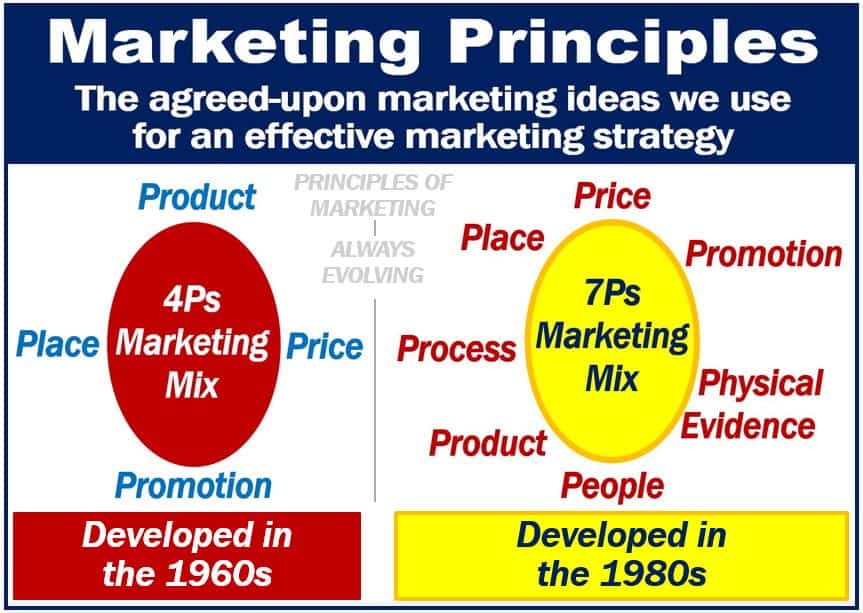Marketing Principles or the Principles of Marketing are agreed-upon marketing ideas companies use for an effective marketing strategy. They are the principles upon which we build product promotion strategies. We can use marketing principles for the effective promotion of either goods or services.
Some companies may follow the 4Ps Strategy (or 4P Strategy). The term ‘4Ps’ stands for product, price, place, and promotion. Some people refer to it as the 4P Marketing Matrix.
Other companies, on the other hand, may have built up their own marketing principles. In most cases, they are the same as or vary slightly from the 4P strategy.
With the advent of data analytics, marketing strategies are increasingly driven by consumer behavior insights, refining the application of the 4Ps to achieve greater market relevance.
Marketing principles – 4P Strategy/Matrix
The principle of the 4P Marketing Strategy or Matrix is that marketing decisions tend to fall into four categories – product, place, price, and promotion. We refer to them as four ‘controllable‘ categories. They are ‘controllable’ because our efforts affect them or their outcomes.
When you combine all your marketing goals and objectives into one plan, you have a marketing strategy.
Government policy or rules and regulations, on the other hand, are ‘uncontrollable‘ categories – our efforts do not influence their outcomes.
A good marketing executive will carefully position the company’s product in each category. The strategy will subsequently generate the greatest response from the target market.

The four marketing principles
Product
In this category, we focus on the benefits and features of the product. We should also consider product interaction. Below is a list of some considerations:
- Who wants the product and why? What needs does it satisfy? Does it solve problems for the consumer, or help them overcome challenges?
- Which of the product’s features help it meet the needs of the consumer?
- Does the product have a competitive advantage? If so, what is it? A competitive advantage is something the product has that makes it stand out from competitors’ goods. It could be the price, quality, a guarantee, or after-sales service.
- Ask representative samples of consumers to try out the product. Take careful note of their feedback regarding its pros and cons. Also, ask them whether the product lacks features. Ask them how it compares to competing products.
Place
Where the manufacturer makes the product and where people buy it can significantly influence its price. Location can also affect customer service and how quickly you can respond to orders and customer requests.
In this category, you should consider the following factors:
- Where is the best place to sell it? Where are consumers or potential purchasers going to look for it?
- How are you going to get the product to where the consumers are?
- Is this a B2B or B2C product? B2B means business-to-business, while B2C means business-to-customer. In other words, are you going to sell to businesses or directly to consumers? With some products, the government is the main customer. The government might even be the only customer. A company that sells mainly to the government is a B2G (business-to-government) business. Defense contractors are usually B2G businesses.
Price
The price of your product can determine many things, including your profit margin and investments for future growth. Price also determines what kind of discounts or special deals you can offer.
When setting the price, you must make sure that the consumer feels that the purchase is worth it. In other words, he or she must perceive it as a good and worthwhile deal.
As far as the consumer is concerned, price is not everything. Quality, for example, and after-sales service also matter. However, price is an important consideration.
Your product’s price must be competitive. If there are rivals in the marketplace, you need to know as much as you can about their pricing strategies.
Promotion
If you want people to buy your product, you must make sure they know about it. Among the four marketing principles, promotion is one that many people do not take seriously enough.
You need to determine how you will get your marketing message to your target market, and when you will begin promoting it. If the product is seasonal, knowing when and how to promote it is crucial.
Marketing principles – 7Ps
Not all marketing principles consist of the 4Ps. There is also the 7Ps marketing mix.
The seven Ps are:
- Product
- Place
- Price
- Promotion
- People
- Physical Environment
- Process
Changes in communication include, for example, social media.
The expansion of e-commerce has necessitated the evolution of marketing principles to encompass digital and social media platforms, broadening the scope of promotion and customer engagement.
Example sentences
Below you can see some example sentences containing “marketing principles,” to show how we can use the term in context:
- “The foundation of our campaign strategy is built on well-established marketing principles that prioritize customer engagement and brand consistency.”
- “When launching a new product, it’s crucial to adhere to core marketing principles to ensure a cohesive and effective go-to-market strategy.”
- “The company’s success can be attributed to its strict adherence to marketing principles, which have fostered strong customer loyalty and brand awareness.”
Marketing
Marketing is a management process through which goods and services move from concept to the consumer.
It includes identifying a product, determining its demand, deciding on a price, and selecting distribution channels. It also includes creating and implementing a promotional strategy.
